河南农业大学:《生物化学》课程PPT教学课件(本科双语教学)第四章 糖类代谢 Carbohydrates

Chapter 4 Carbohydrates "The discovery of honey"-Piero de Cosm0(1462). Courtesy of the Worcester Art Museum)
Chapter 4 Carbohydrates "The discovery of honey"—Piero de Cosimo (1462). (Courtesy of the Worcester Art Museum)

Carbohydrates are the single most abundant class of organic molecules found in nature.The name carbohydrate arises from the basic molecular formula (CH2O)which can be rewritten (C.H2O) to show that these substances are hydrates of carbon,where n-3 or more
Carbohydrates are the single most abundant class of organic molecules found in nature. The name carbohydrate arises from the basic molecular formula (CH2O)n, which can be rewritten (C·H2O)n to show that these substances are hydrates of carbon, where n=3 or more
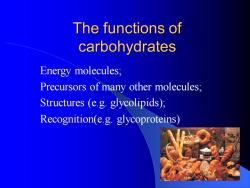
The functions of carbohydrates Energy molecules; Precursors of many other molecules; Structures (e.g.glycolipids); Recognition(e.g.glycoproteins)
The functions of carbohydrates Energy molecules; Precursors of many other molecules; Structures (e.g. glycolipids); Recognition(e.g. glycoproteins)
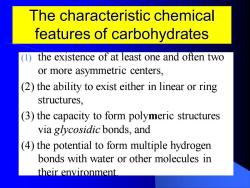
The characteristic chemical features of carbohydrates (1)the existence of at least one and often two or more asymmetric centers, (2)the ability to exist either in linear or ring structures, (3)the capacity to form polymeric structures via glycosidic bonds,and (4)the potential to form multiple hydrogen bonds with water or other molecules in their environment
The characteristic chemical features of carbohydrates (1) the existence of at least one and often two or more asymmetric centers, (2) the ability to exist either in linear or ring structures, (3) the capacity to form polymeric structures via glycosidic bonds, and (4) the potential to form multiple hydrogen bonds with water or other molecules in their environment
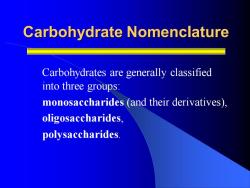
Carbohydrate Nomenclature Carbohydrates are generally classified into three groups: monosaccharides (and their derivatives). oligosaccharides, polysaccharides
Carbohydrate Nomenclature Carbohydrates are generally classified into three groups: monosaccharides (and their derivatives), oligosaccharides, polysaccharides
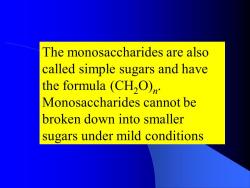
The monosaccharides are also called simple sugars and have the formula(CH2O) Monosaccharides cannot be broken down into smaller sugars under mild conditions
The monosaccharides are also called simple sugars and have the formula (CH2O)n . Monosaccharides cannot be broken down into smaller sugars under mild conditions
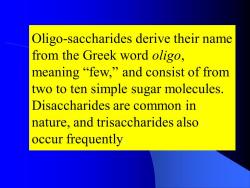
Oligo-saccharides derive their name from the Greek word oligo, meaning“few,”and consist of from two to ten simple sugar molecules. Disaccharides are common in nature,and trisaccharides also occur frequently
Oligo-saccharides derive their name from the Greek word oligo, meaning “few,” and consist of from two to ten simple sugar molecules. Disaccharides are common in nature, and trisaccharides also occur frequently
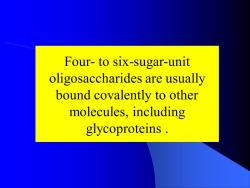
Four-to six-sugar-unit oligosaccharides are usually bound covalently to other molecules,including glycoproteins
Four- to six-sugar-unit oligosaccharides are usually bound covalently to other molecules, including glycoproteins
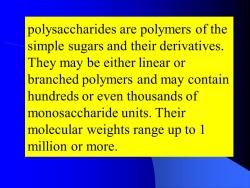
polysaccharides are polymers of the simple sugars and their derivatives. They may be either linear or branched polymers and may contain hundreds or even thousands of monosaccharide units.Their molecular weights range up to 1 million or more
polysaccharides are polymers of the simple sugars and their derivatives. They may be either linear or branched polymers and may contain hundreds or even thousands of monosaccharide units. Their molecular weights range up to 1 million or more
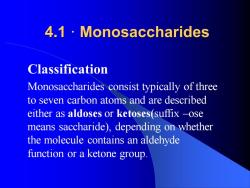
4.1 Monosaccharides Classification Monosaccharides consist typically of three to seven carbon atoms and are described either as aldoses or ketoses(suffix -ose means saccharide),depending on whether the molecule contains an aldehyde function or a ketone group
4.1 ·Monosaccharides Classification Monosaccharides consist typically of three to seven carbon atoms and are described either as aldoses or ketoses(suffix –ose means saccharide), depending on whether the molecule contains an aldehyde function or a ketone group
按次数下载不扣除下载券;
注册用户24小时内重复下载只扣除一次;
顺序:VIP每日次数-->可用次数-->下载券;
- 河南农业大学:《生物化学》课程PPT教学课件(本科双语教学)第三章 酶 Protein Structures.ppt
- 河南农业大学:《生物化学》课程PPT教学课件(本科双语教学)第一章 核酸化学 Chemistry Is the Logic of Biological Phenomena.ppt
- 河南农业大学:《生物化学》课程教学资源(实验指导)实验十六 用阳离子交换树脂摄取氯化钠.doc
- 河南农业大学:《生物化学》课程教学资源(实验指导)实验十四 还原糖和总糖含量的测定.doc
- 河南农业大学:《生物化学》课程教学资源(实验指导)实验十三 蛋白质的两性性质及等电点的测定.doc
- 河南农业大学:《生物化学》课程教学资源(实验指导)实验十二 聚丙烯酰胺凝胶电泳.doc
- 河南农业大学:《生物化学》课程教学资源(实验指导)实验十一 蛋白质脱盐.doc
- 河南农业大学:《生物化学》课程教学资源(实验指导)实验十 脲酶Km值测定.doc
- 河南农业大学:《生物化学》课程教学资源(实验指导)实验九 酶的基本性质.doc
- 河南农业大学:《生物化学》课程教学资源(实验指导)实验七 小麦萌发前后淀粉酶活力的比较.doc
- 河南农业大学:《生物化学》课程教学资源(实验指导)实验六 蛋白质含量测定(考马斯亮蓝G-250法).doc
- 河南农业大学:《生物化学》课程教学资源(实验指导)实验五 蛋白质的水解和氨基酸的纸层析法分离.doc
- 河南农业大学:《生物化学》课程教学资源(实验指导)实验四 甲醛滴定法测定氨基氮.doc
- 河南农业大学:《生物化学》课程教学资源(实验指导)实验三 酵母RNA的提制(浓盐法).doc
- 河南农业大学:《生物化学》课程教学资源(实验指导)实验二 菜花(花椰莱)中核酸的分离和鉴定.doc
- 河南农业大学:《生物化学》课程教学资源(实验指导)实验一 醋酸纤维薄膜电泳分离核苷酸.doc
- 河南师范大学:《物理化学》课程教学资源(PPT课件)第九章 可逆电池.ppt
- 河南师范大学:《物理化学》课程教学资源(PPT课件)第八章 电解质溶液.ppt
- 河南师范大学:《物理化学》课程教学资源(PPT课件)第七章 化学动力学.ppt
- 河南师范大学:《物理化学》课程教学资源(PPT课件)第五章 相平衡.ppt
- 河南农业大学:《生物化学》课程PPT教学课件(本科双语教学)第五章 脂类代谢 Lipid.ppt
- 河南农业大学:《生物化学》课程PPT教学课件(本科双语教学)第九章 代谢调节 Specificity Is the Result of Molecular Recognition.ppt
- 河南农业大学:《生物化学》课程PPT教学课件(本科双语教学)第十章 生物膜 Mechanism of Enzyme Action.ppt
- 河南农业大学:《生物化学》课程PPT教学课件(基础生物化学)绪论 Biochemistry(主讲:陈新建).ppt
- 河南农业大学:《生物化学》课程PPT教学课件(基础生物化学)第一章 核酸化学.ppt
- 河南农业大学:《生物化学》课程PPT教学课件(基础生物化学)第二章 蛋白质.ppt
- 河南农业大学:《生物化学》课程PPT教学课件(基础生物化学)第三章 酶 Enzyme.ppt
- 河南农业大学:《生物化学》课程PPT教学课件(基础生物化学)第四章 糖类代谢.ppt
- 河南农业大学:《生物化学》课程PPT教学课件(基础生物化学)第六章 含氮化合物的代谢.ppt
- 河南农业大学:《生物化学》课程PPT教学课件(基础生物化学)第七章 核酸的生物合成.ppt
- 河南农业大学:《生物化学》课程PPT教学课件(基础生物化学)第八章 蛋白质的生物合成.ppt
- 河南农业大学:《生物化学》课程PPT教学课件(基础生物化学)第九章 物质代谢的调控.ppt
- 河南农业大学:《生物化学》课程PPT教学课件(基础生物化学)第十章 生物膜.ppt
- 河南农业大学:《生物化学》课程教学课件(PPT讲稿)生物化学绪论.ppt
- 河南农业大学:《生物化学》课程教学课件(PPT讲稿)第二章 蛋白质化学.ppt
- 河南农业大学:《生物化学》课程教学课件(PPT讲稿)第三章 酶学.ppt
- 河南农业大学:《生物化学》课程教学课件(PPT讲稿)第四章 糖类代谢.ppt
- 河南农业大学:《生物化学》课程教学课件(PPT讲稿)第六章 含氮化合物代谢.ppt
- 河南农业大学:《生物化学》课程教学课件(PPT讲稿)第七章 核酸的生物合成.ppt
- 河南农业大学:《生物化学》课程教学课件(PPT讲稿)第八章 蛋白质的生物合成(1/2).ppt
